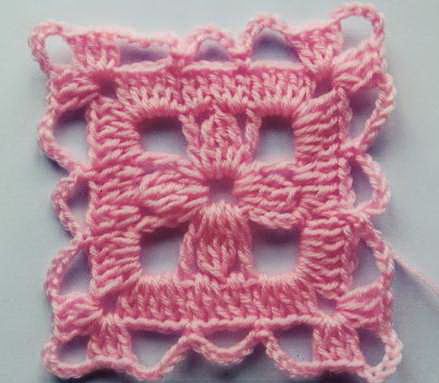Pattern flower square, although square in shape, its knit in a circle. Begin to knit with chain of eight loops, having closed her ring in the first row to link a chain of four loops, to perform two nakida, slip the hook under the chain, grab the working thread and pull the loop, catch the working thread over the ring and pull it through two loops on the hook at one time, to catch again the working thread, and knit into two loops with the hook. On the hook two loops. To perform two nakida, enter the hook under the ring, grab the working thread and pull a loop, catch the working thread, and knit into two loops with the hook in one go. Then pick up the working thread and purl into the two loops. On the hook - three loops. Make two nakida, stretch the loop under the ring, and knit into the loops with the hook in two stages, in two loops together for the reception. On the hook - four loops. To link six of these reduced columns, i.e. columns with two yo-related underemployed: instead of three methods of proveski loops with hook perform only two steps, at two loops for each meal and accumulate the rest of the loop on the hook. These seven loops provyazat all together when knitting the last of the sixth column with two yo, in the third technique, and then associate, tightening their belts, the air loop. Linked a shortened column of the six columns with two yo - lumpy. After an air loop to associate a column with two yo, Nugs will be like framed on both sides by such columns,

Next, knit a chain of five loops, a column with two yo and one air loop, after which the cone, the air loop and again a column with two yo. Just knit on circle four such motive, connected by a chain of five loops. To close the series. The pattern takes the form of a square, the sides of which are bumps, and in corners - chain.
In the second row, linking a chain of two air loops for lifting, tie nine columns with nakida, which, together with this chain, form the group of the ten columns, five of which are connected above the cone and five under corner chain. Then tie a chain of three loops and 15 columns with nakida on each side of the square after completing each group in the corner, a chain of three loops, and on the side, which began to knit, to complement a series of five columns with stitches in the corner chain and to close a number.
The third and last row start to knit with chain of six loops, which is fixed to the column without nakida on the fifth column with nakida previous row. To associate the following chain of six loops, and then a group of three columns with nakida under corner chain linked to another chain of six loops and a group of three columns with nakida into the same corner chain. To link two chains of six loops each, securing them on the other side of the square columns without nakida in each of the fifth column with nakida previous row. After the third chain link of the first group of three columns with nakida under corner chain and so on. Thus, on each side of the square I knit three chains of six loops each, the average of them is attached with both ends to the side of the square columns without nakida, while in each corner of the square knit two groups of three columns with nakida in each, and between them a chain of six loops.
Associating the first square, begin to knit the second. In the last row connect it with the first one at the party in five places, namely in the middle of each chain, inserting the hook once tied three air loop, under appropriate chain linked square, stretch the loop and, provatas her from the fourth loop, knit the remaining loops of the chain.
These squares include mating products on his finish at the edges, they can be knit blouses, jackets, shawls and so on.



